Soccermatics: Barcelona have found perfect footballing symmetry
Maths professor David Sumpter uses symmetry to look at why Barcelona are so successful. Can anybody find a tactic to counter it?
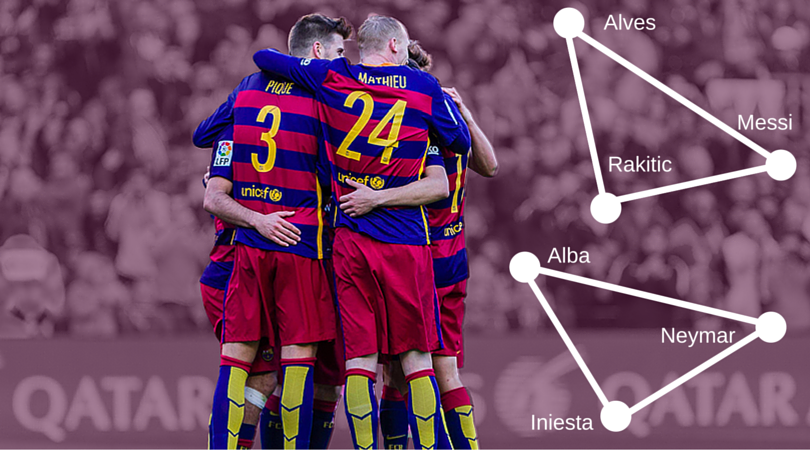
The year 2015 was a spectacular one for Barcelona, in which they won the treble of La Liga, Copa del Rey and Champions League. Their success is continuing in 2016: Luis Enrique's side are top of La Liga and remain on course to both cup competitions once again.
One reason for Barça's success is simple: MSN. Lionel Messi is back on his best game, Neymar is fast developing as the Argentine's heir, and Luis Suarez is unstoppable in front of goal. There is, however, more to Barcelona's success than just skill on the ball.
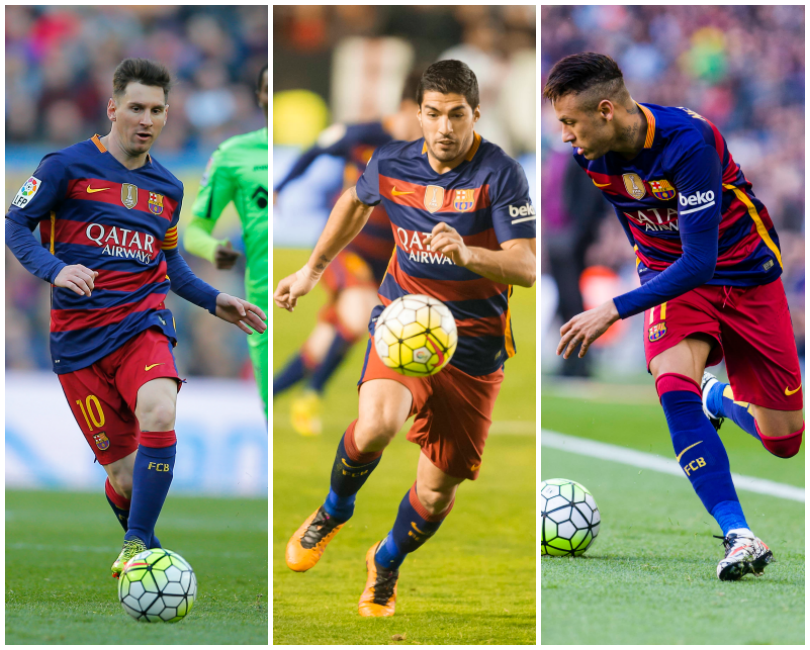
The Catalans have always had world-class players, but that's not always enough. In 2013 they were wiped out 7-0 on aggregate by Bayern Munich, not because their players weren’t skilful but because they had been found out tactically. By pressing continuously, Bayern were able to overwhelm them.
There is however more to the success of Barcelona than just skill on the ball
It took a while for Barça to recover from this defeat. When Enrique took over as manager in 2014 he needed new tactics. Possession was no longer enough to win matches. He had three superstars at his disposal, together with a squad of players all comfortable with possessing and passing the ball. But he needed to build these components into a winning formation.
Enrique switches tactics
The tactical answer that Enrique came up with was symmetry. He gave Messi the right side of the pitch. He gave Neymar the left. He then assigned two players to support each of them. With Messi, this is typically Ivan Rakitic and Dani Alves. With Neymar, it's Jordi Alba and Andres Iniesta.

Neymar and Alba work together down the left
The best features, fun and footballing quizzes, straight to your inbox every week.
We can also see this formation in the passing network for Barcelona below in their 6-1 Champions League match against Roma back in November.
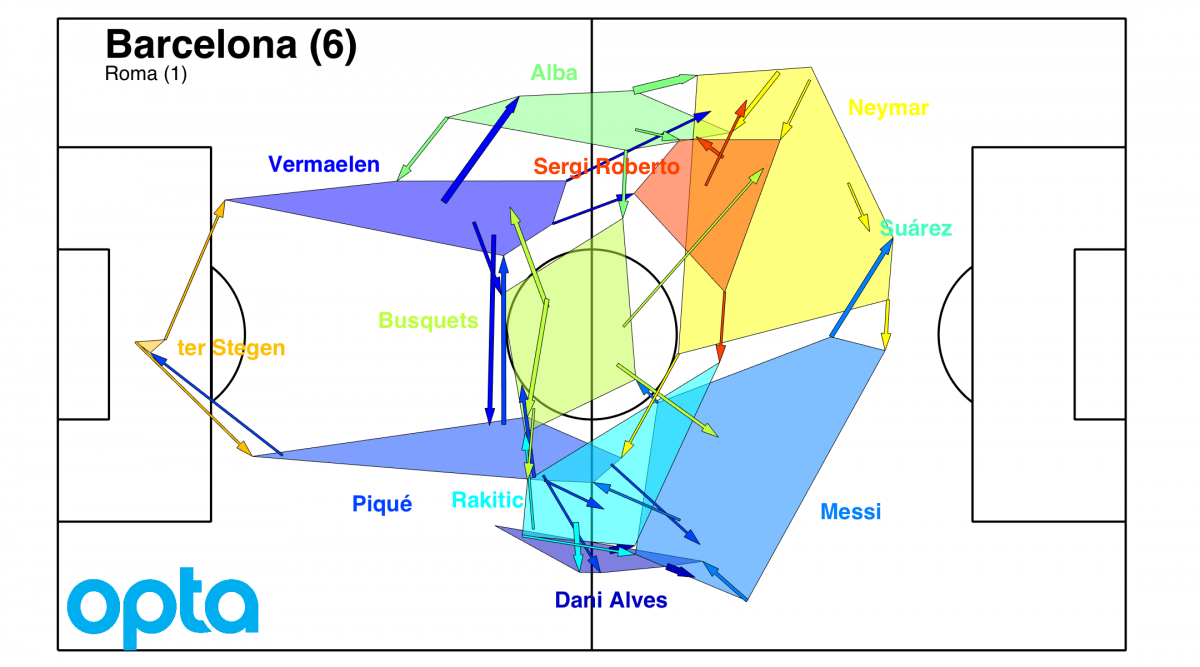
These networks have been presented in an earlier Soccermatics article. Each of the arrows in this plot indicates the average point on the pitch where players passed to each other. The start of the arrow shows where the pass came from, and the tip shows where it went. The shapes, or zones, connect up all the passes for each player. The zones show the areas where most passes are made between players.
Passing networks
The important point about Barcelona is that the zones the players occupy have the same form of symmetry for each match
What is striking about this network is the line of symmetry down the middle of the pitch. Thomas Vermaelen is the mirror image of Gerard Pique. Sergio Busquets is in the centre. Then Messi and Neymar each have their own, mirror image zones on the left and right sides, respectively.
Behind Messi’s zone, Rakitic and Dani Alves circulate the ball with passes. And behind Neymar, Sergi Roberto and Alba do exactly the same thing. Suarez was less strongly connected in this match, with only Neymar reaching him repeatedly, but he typically spearheads the attack at the front.
RECOMMENDED Is it time to acknowledge Sergio Busquets as the best midfielder in the world?
The important point about Barcelona is that the zones the players occupy have the same form of symmetry for each match. When they won El Clasico in Madrid, the passing zones looked like this.
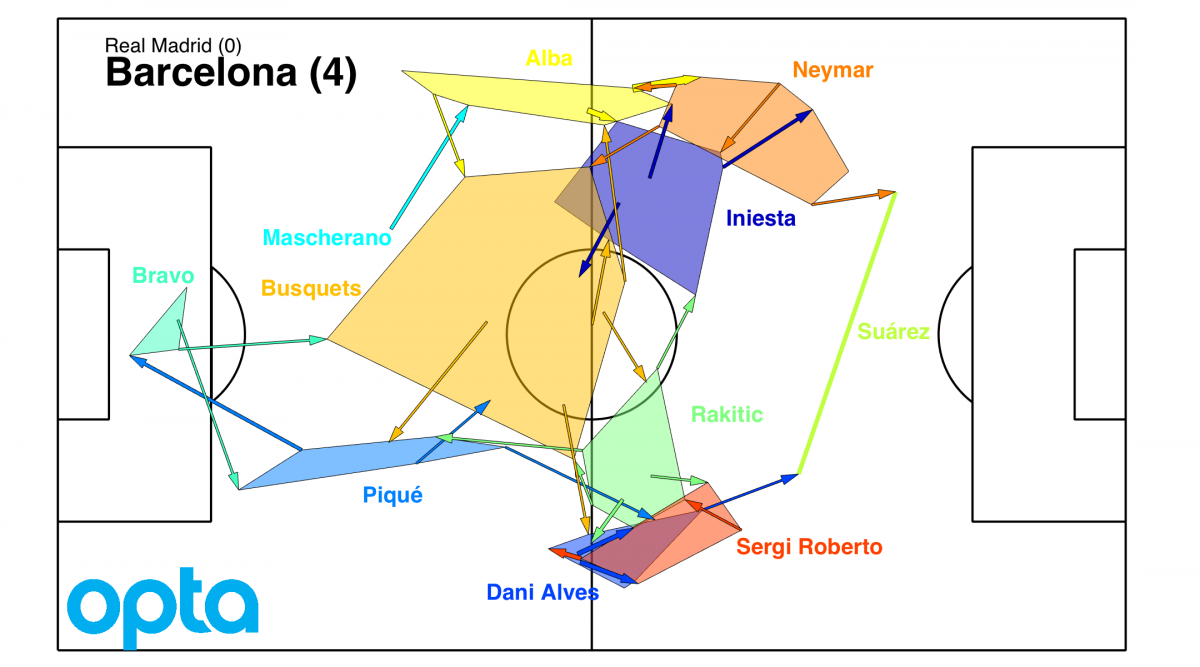
Messi didn’t come on until 57 minutes, so he is missing from the attack, and Javier Mascherano had to go off after 23 minutes, so managed only a few passes in defence. But even with these changes, the same structure remained. Busquets is the central point at the back. The trio of Iniesta, Neymar and Alba are generating chances from the left and Rakitic, Sergi Roberto and Dani Alves on the right. Suarez is now centrally placed at the top.
The build-up in Stats Zone to the first two goals against Real Madrid is shown below.

Rotational passing
Suarez's first goal after 10 minutes was created by the right-hand trio. The ball was first played back from the left over to the right wing. It was rotated between Rakitic and Dani Alves, before Sergi Roberto found the penetrating pass (marked in yellow) to Suarez. The second goal was a mirror image of the first; the ball rotating on the left until Iniesta broke free and found the pass to Neymar for 2-0. The third was the same again, this time with Iniesta scoring himself.
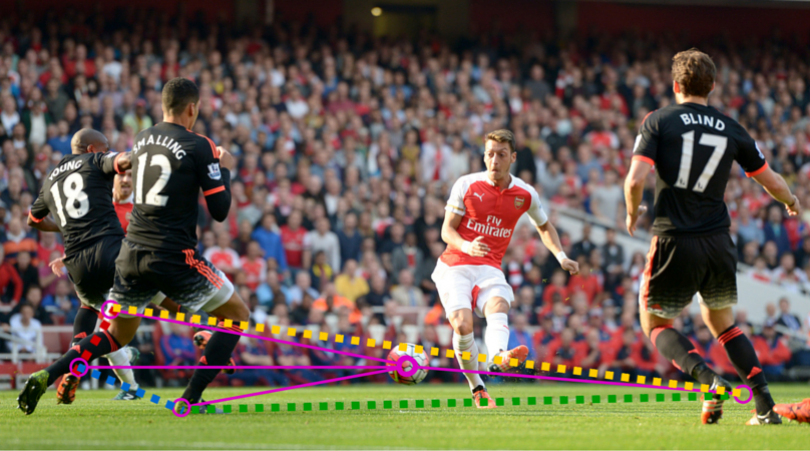
Goal after goal for Barcelona last year was created this way. They rotate the ball on one side of the pitch, drawing in the opposition, then suddenly they transition to attack. If they get stuck on the left then the ball goes back to Busquets and comes out again on the right, and vice-versa.
The secret of this system lies not so much in which player plays where: Sergi Roberto, for example, has moved between different roles but maintains the overall team structure. The secret lies in keeping the symmetry, to making sure the team is well-balanced.
There is, however, one word of warning for Barcelona. The consistency of their system could end up being its downfall. Just as Barcelona’s tiki-taka first triumphed in 2011 and was found out in 2013, there could well be a way to break down Barcelona’s new symmetry. It will be interesting to see if any team manages to do it during 2016.
